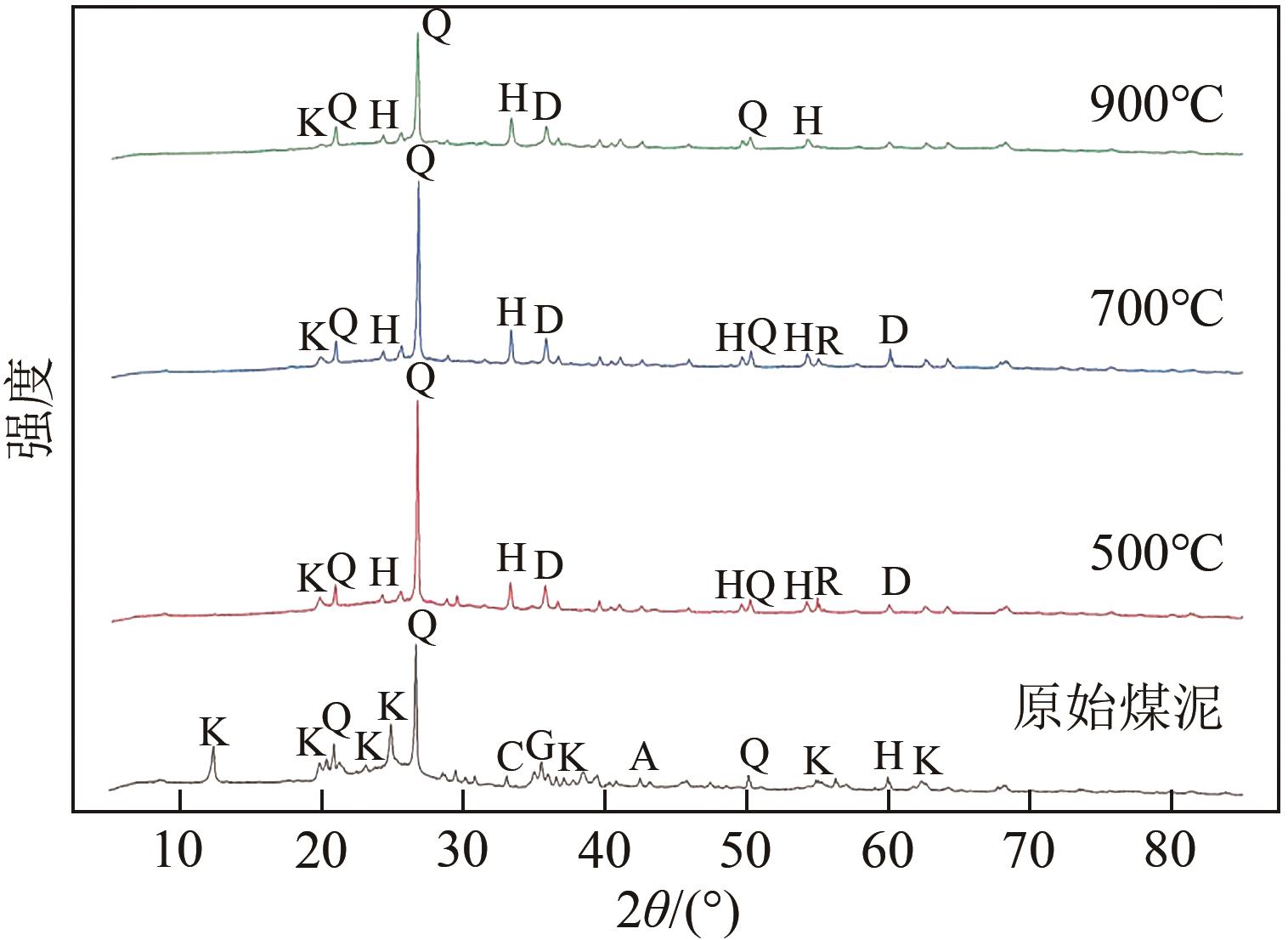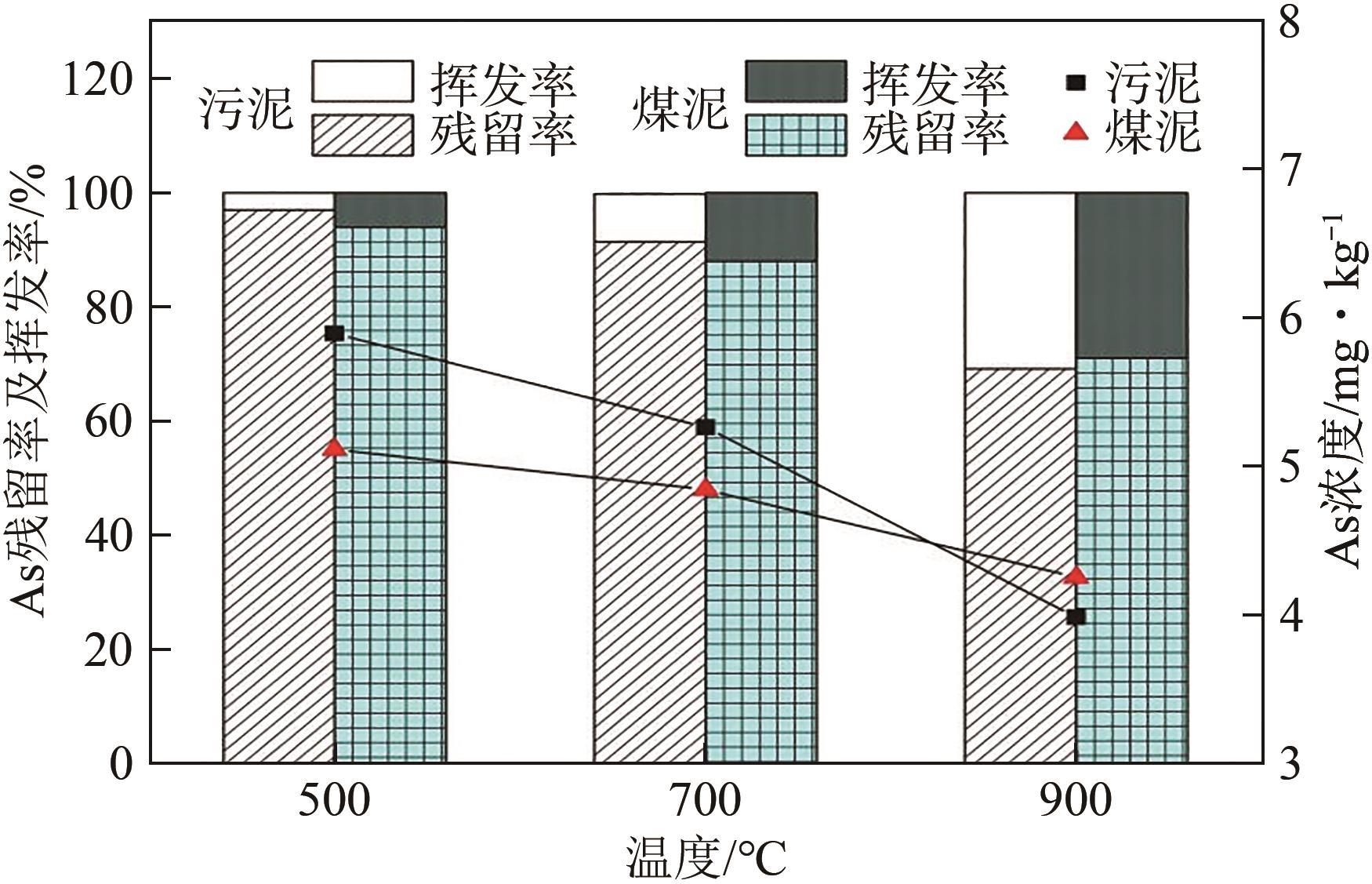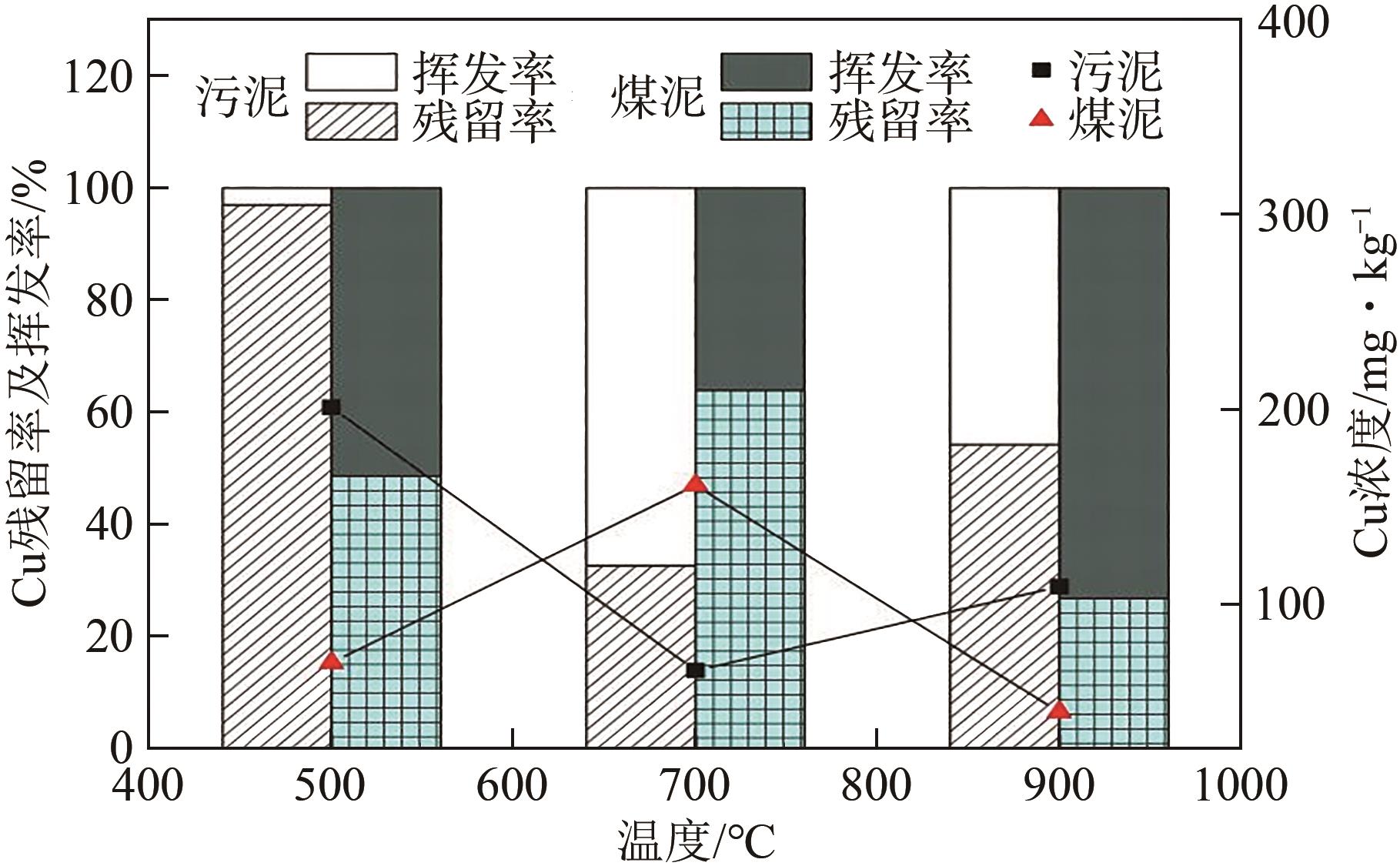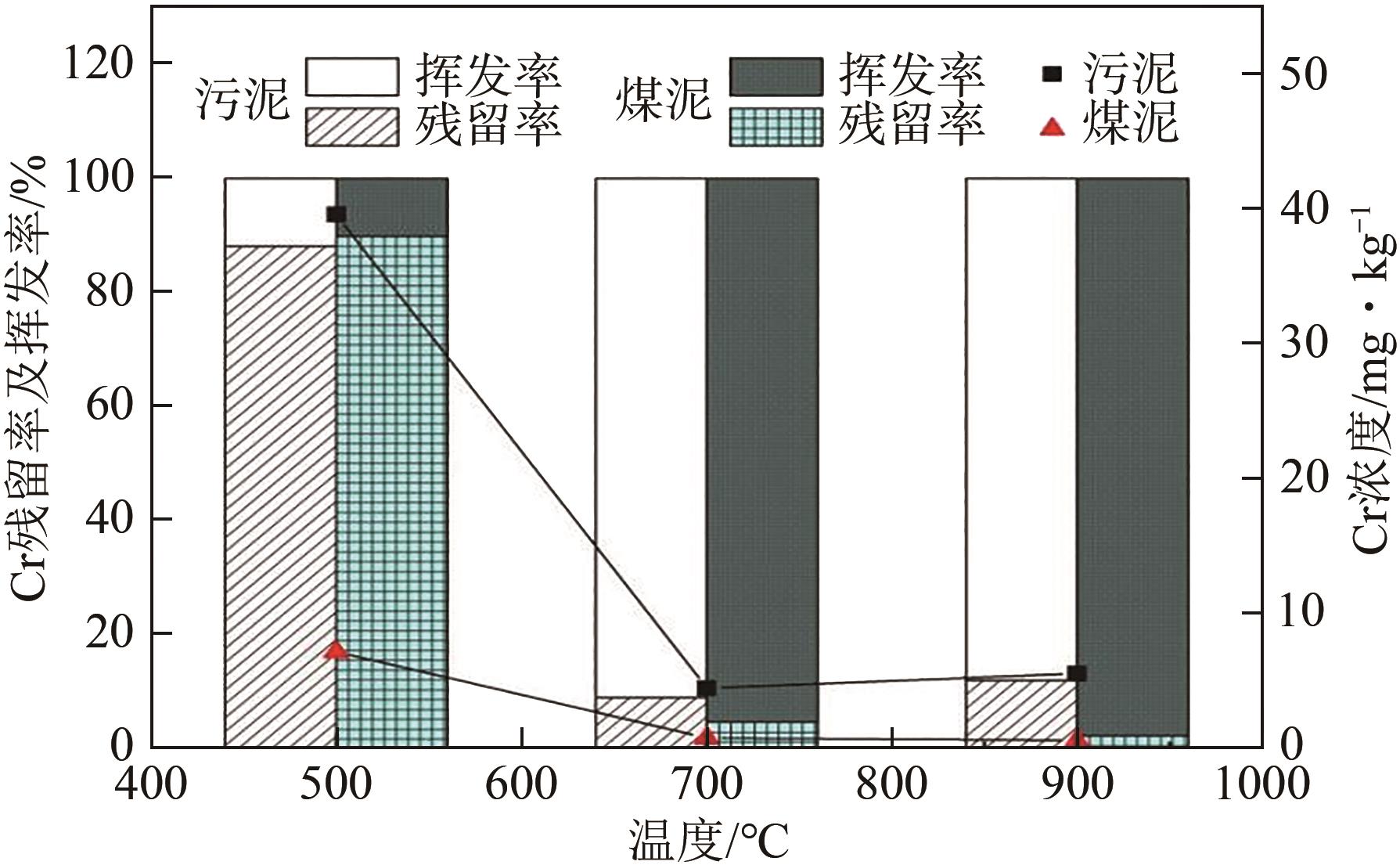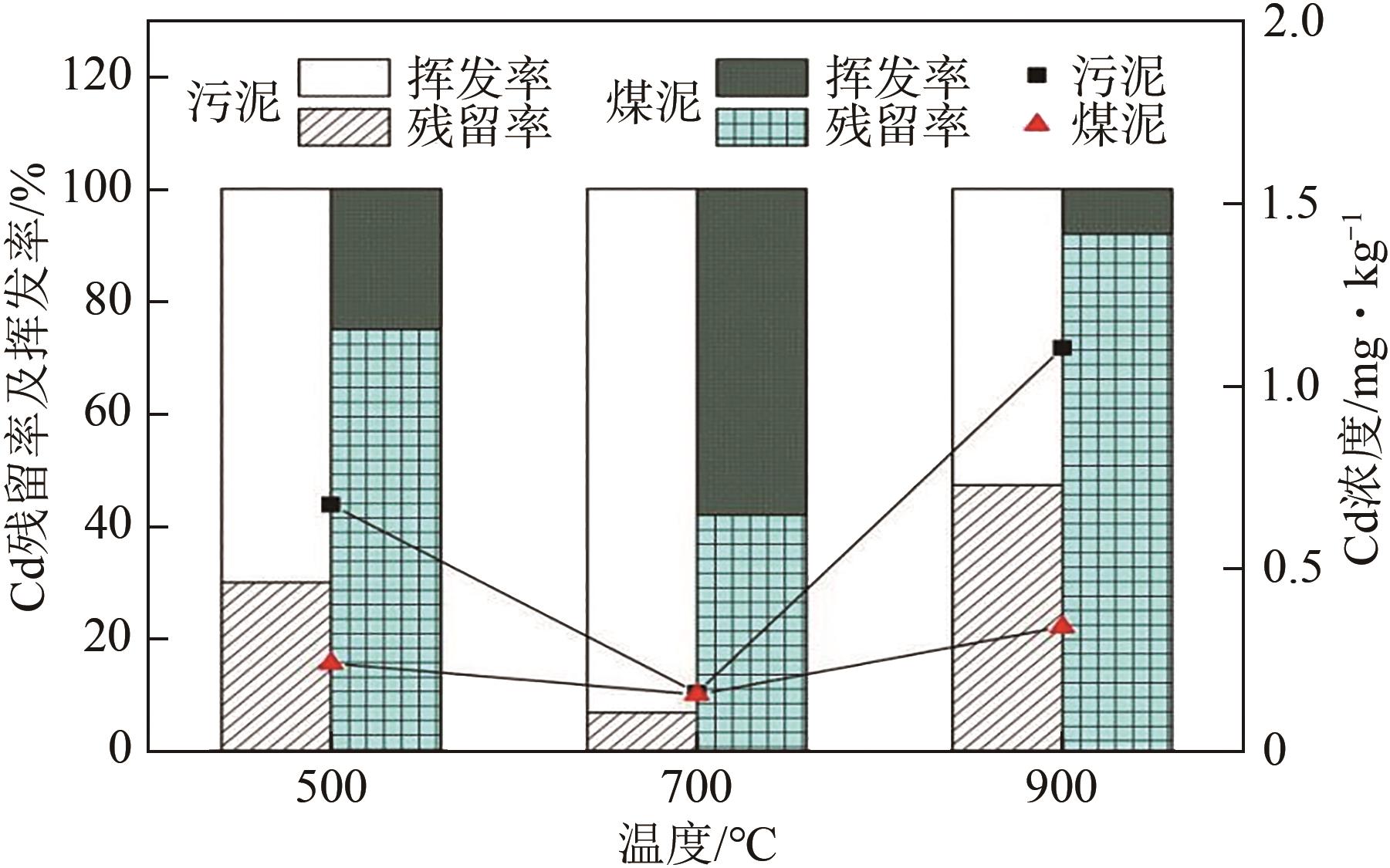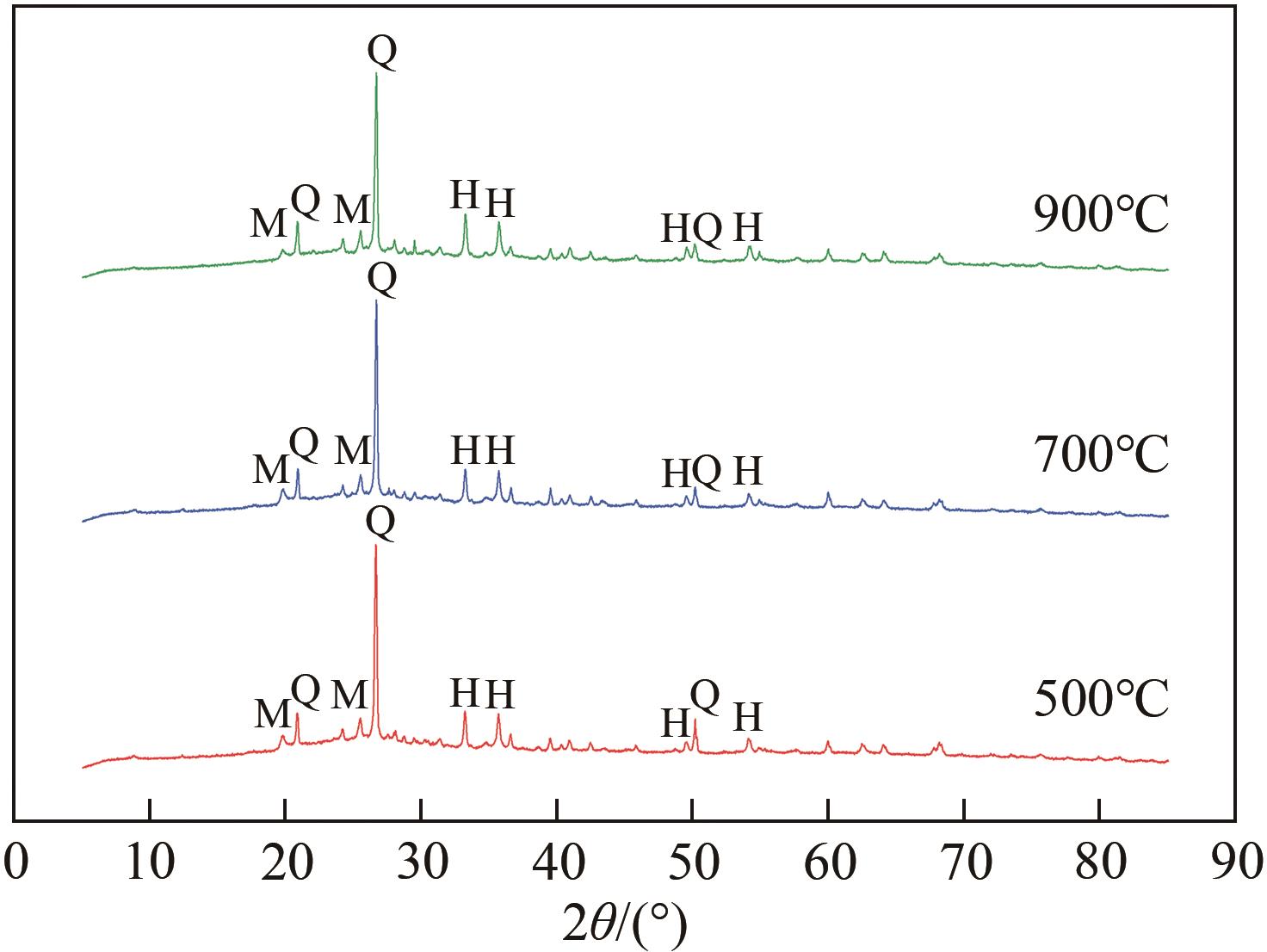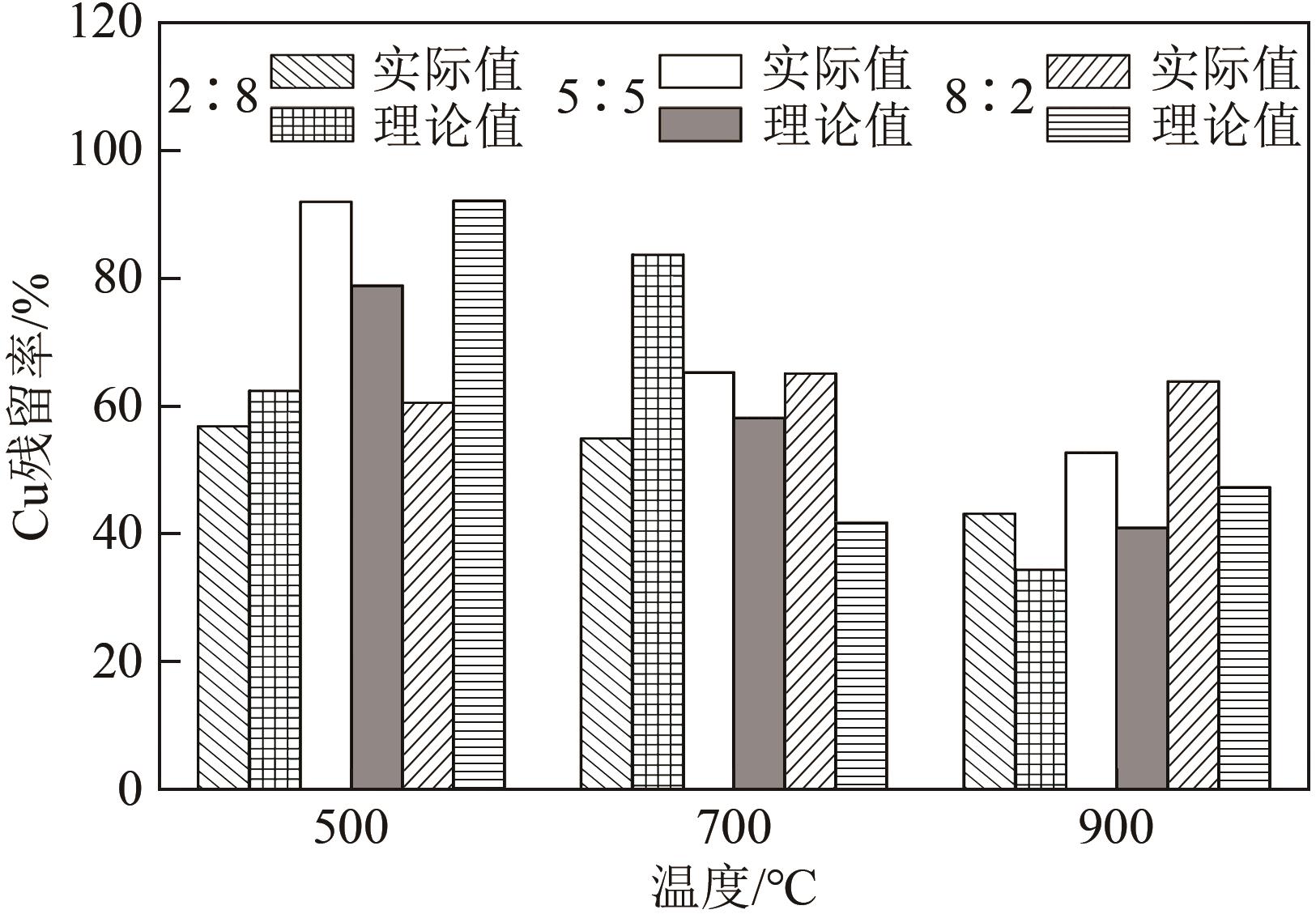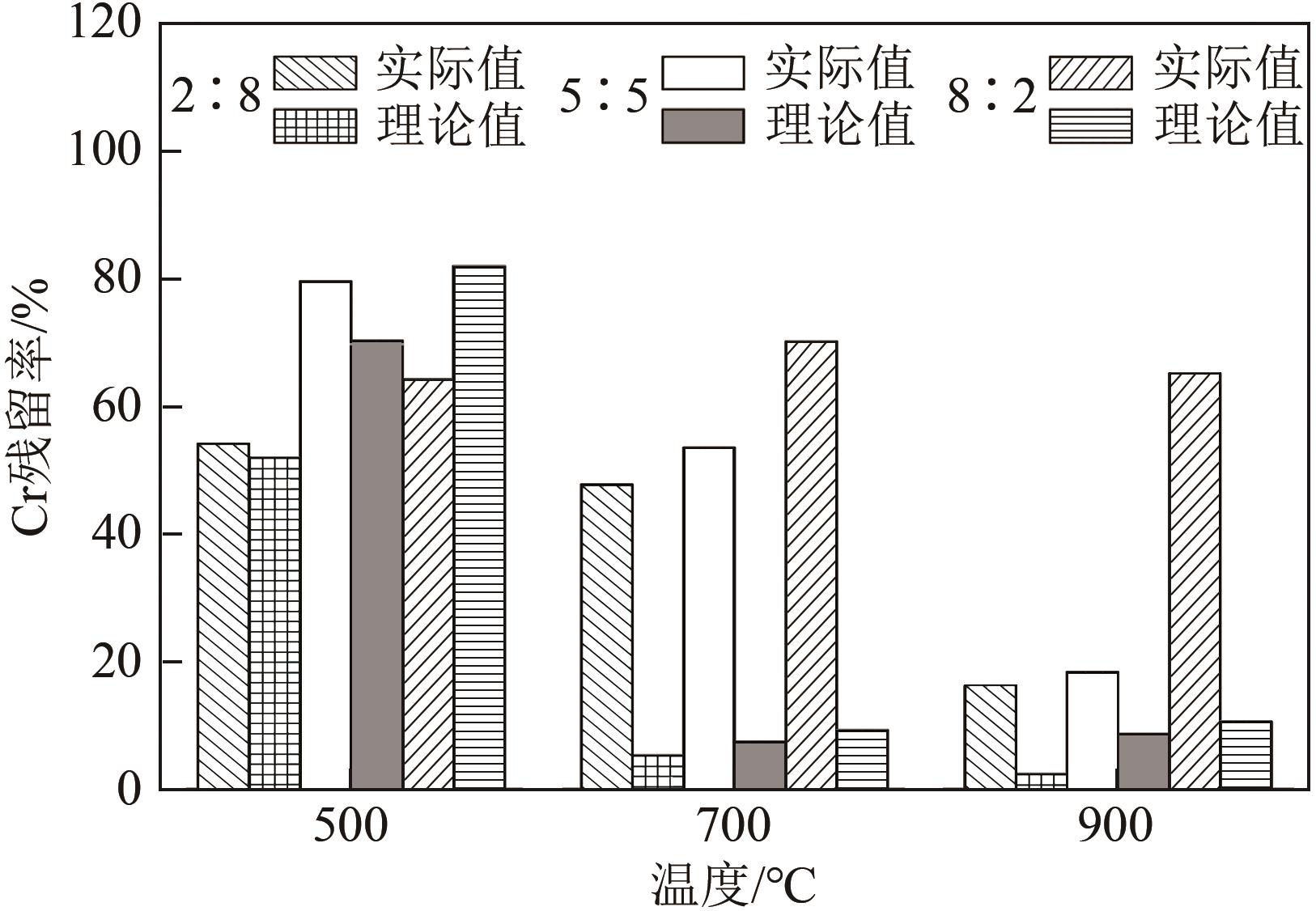化工进展 ›› 2023, Vol. 42 ›› Issue (6): 3233-3241.DOI: 10.16085/j.issn.1000-6613.2022-1489
污泥与煤泥混烧对重金属固留特性的影响
郑昕( ), 贾里, 王彦霖, 张靖超, 陈世虎, 乔晓磊, 樊保国(
), 贾里, 王彦霖, 张靖超, 陈世虎, 乔晓磊, 樊保国( )
)
- 太原理工大学电气与动力工程学院,山西 太原 030024
-
收稿日期:2022-08-11修回日期:2022-10-27出版日期:2023-06-25发布日期:2023-06-29 -
通讯作者:樊保国 -
作者简介:郑昕(1996—),男,硕士研究生,研究方向为能源动力。E-mail:zx358496420@163.com。 -
基金资助:国家自然科学基金(U1910214)
Effect of sewage sludge mixed with coal slime on heavy metal retention characteristics
ZHENG Xin( ), JIA Li, WANG Yanlin, ZHANG Jingchao, CHEN Shihu, QIAO Xiaolei, FAN Baoguo(
), JIA Li, WANG Yanlin, ZHANG Jingchao, CHEN Shihu, QIAO Xiaolei, FAN Baoguo( )
)
- College of Electrical and Power Engineering, Taiyuan University of Technology, Taiyuan 030024, Shanxi, China
-
Received:2022-08-11Revised:2022-10-27Online:2023-06-25Published:2023-06-29 -
Contact:FAN Baoguo
摘要:
针对污泥与煤泥混烧时重金属(Pb、As、Cu、Cr、Cd)的迁移特性以及在混烧条件下矿物质对重金属固留效果的影响,利用电热管式炉并结合电感耦合等离子体质谱(ICP-MS)、X 射线衍射(XRD)等表征分析手段,研究不同燃烧条件下污泥与煤泥单独燃烧及多比例混烧过程。结果表明:污泥单独燃烧时,As的挥发率随温度升高而上升,Pb、Cu、Cd、Cr的挥发率在700℃时达到顶峰,在700~900℃时随着温度升高而下降。对于煤泥,Pb、Cr的挥发率随温度升高逐渐上升,Cu的挥发率随温度升高呈现先下降后上升的趋势,700℃时达到最低点,Cd的挥发率则相反。对于污泥-煤泥耦合燃烧过程,污泥-煤泥在5∶5掺混比条件下重金属固留率相比于2∶8及8∶2掺混比条件有所提升,5∶5掺混比条件下900℃燃烧温度时污泥-煤泥中矿物质交互作用对Pb、As、Cu、Cr和Cd实际残留率相比理论值分别提高了148.9%、5.8%、28.6%、112%和75.7%。混烧过程中重金属的固留主要受到矿物组分之间所发生的交互作用的影响。其中,对于单组分燃烧条件,SiO2、Al2O3、Fe2O3易与重金属反应生成难挥发化合物并在灰渣中赋存;而混烧过程可以促进硅铝酸盐及含铁化合物的分解,进而在大量生成SiO2等化合物的基础上,促进重金属残留率的提升。
中图分类号:
引用本文
郑昕, 贾里, 王彦霖, 张靖超, 陈世虎, 乔晓磊, 樊保国. 污泥与煤泥混烧对重金属固留特性的影响[J]. 化工进展, 2023, 42(6): 3233-3241.
ZHENG Xin, JIA Li, WANG Yanlin, ZHANG Jingchao, CHEN Shihu, QIAO Xiaolei, FAN Baoguo. Effect of sewage sludge mixed with coal slime on heavy metal retention characteristics[J]. Chemical Industry and Engineering Progress, 2023, 42(6): 3233-3241.
| 样品 | 工业分析/% | 元素分析/% | |||||||
|---|---|---|---|---|---|---|---|---|---|
| Mad | Aad | Vad | FCad | Cd | Hd | Nd | Od | Sd | |
| 污泥 | 2.44 | 47.33 | 46.31 | 3.92 | 24.78 | 3.002 | 4.33 | 27.77 | 1.469 |
| 太选煤泥 | 0.38 | 51.16 | 13.04 | 35.42 | 37.7 | 2.17 | 1.03 | 2.33 | 5.57 |
表1 污泥和煤泥工业分析及元素分析
| 样品 | 工业分析/% | 元素分析/% | |||||||
|---|---|---|---|---|---|---|---|---|---|
| Mad | Aad | Vad | FCad | Cd | Hd | Nd | Od | Sd | |
| 污泥 | 2.44 | 47.33 | 46.31 | 3.92 | 24.78 | 3.002 | 4.33 | 27.77 | 1.469 |
| 太选煤泥 | 0.38 | 51.16 | 13.04 | 35.42 | 37.7 | 2.17 | 1.03 | 2.33 | 5.57 |
| 样品 | Pb | As | Cu | Cr | Cd |
|---|---|---|---|---|---|
| 污泥 | 9.02 | 2.72 | 98.19 | 22.04 | 1.19 |
| 太选煤泥 | 19.65 | 2.2 | 71.6 | 10.93 | 0.16 |
表2 污泥和煤泥中的重金属含量单位:mg/kg
| 样品 | Pb | As | Cu | Cr | Cd |
|---|---|---|---|---|---|
| 污泥 | 9.02 | 2.72 | 98.19 | 22.04 | 1.19 |
| 太选煤泥 | 19.65 | 2.2 | 71.6 | 10.93 | 0.16 |
| 样品 | SiO2 | Al2O3 | Fe2O3 | P2O5 | CaO | Cl |
|---|---|---|---|---|---|---|
| 污泥 | 20.85 | 6.6 | 29.99 | 16.29 | 8.48 | 0.863 |
| 太选煤泥 | 44.82 | 27.38 | 12.2 | 0.53 | 2.72 | 0.941 |
表3 污泥和煤泥的灰分组成(质量分数,%)
| 样品 | SiO2 | Al2O3 | Fe2O3 | P2O5 | CaO | Cl |
|---|---|---|---|---|---|---|
| 污泥 | 20.85 | 6.6 | 29.99 | 16.29 | 8.48 | 0.863 |
| 太选煤泥 | 44.82 | 27.38 | 12.2 | 0.53 | 2.72 | 0.941 |

图1 污泥在不同燃烧温度下XRD图Q—石英,SiO2;D—磷酸亚铁,Fe3(PO4)2;N—偏磷酸铁,Fe(PO3)3;H—氧化铁,Fe2O3;M—白云母,K{Al2[AlSi3O10](OH)2};I—黄铅矿,Pb2OSO4;K—高岭土,Al2Si2O5(OH)4;G—LiNiFe2O4;Y—硅酸铬,Cr2SiO4;P—磷酸氧铅,Pb4O(PO4)2;V—CdO·Al2O3·3SiO2

图8 5∶5混烧条件下灰渣XRD图Q—石英,SiO2;K—高岭土,Al2Si2O5(OH)4;G—LiNiFe2O4;H—氧化铁,Fe2O3;U—斜硅铜矿,Cu5Si4O12(OH)2;O—砷化铁,FeAs3O9;L—氧化铅,Pb5O8;Z—硅酸锌,ZnSiO3;M—白云母,K{Al2[AlSi3O10](OH)2}
| 1 | 中华人民共和国环境保护部. 污水处理厂污泥处理处置最佳可行技术导(编制研究报告)[EB/OL]. [2022-08-11]. . |
| Ministry of Environmental Protection of the People’s Republic of China. Best available techniques directive for treatment and disposal of sludge from wastewater treatment plant(researching report)[EB/OL]. [2022-08-11]. . | |
| 2 | 张全斌, 周琼芳, 梁婕. 燃煤耦合污泥燃烧技术研究与工程实践[J]. 工业水处理, 2019, 39(11): 7-11. |
| ZHANG Quanbin, ZHOU Qiongfang, LIANG Jie. Co-combustion of coal and sludge technology and its engineering practice in coal-fired power plant[J]. Industrial Water Treatment, 2019, 39(11): 7-11. | |
| 3 | 姚金玲. 污水处理厂污泥处理处置技术评估[D]. 北京: 中国环境科学研究院, 2010. |
| YAO Jinling. The assessment of municipal sewage sludge treatment and disposal technologies[D]. Beijing: Chinese Research Academy of Environmental Sciences, 2010. | |
| 4 | 叶子瑞. 国内外污泥处置和管理现状[J]. 环境卫生工程, 2002(2):85-88. |
| YE Zirui. National and international sludge disposal and management analysis[J]. Environmental Sanitation Engineering, 2002(2): 85-88. | |
| 5 | 郭晋荣. 污泥与煤泥混烧过程中汞排放特性试验研究[D]. 太原: 太原理工大学,2021. |
| GUO Jinrong. Study on characteristics of mercury emission during the co-combustion of coal slime and sludge[D]. Taiyuan: Taiyuan University of Technology.2021. | |
| 6 | 徐向鹏, 钟文琪, 陈曦, 等. 污泥煤泥协同燃烧动力学及污染物排放特性[J]. 东南大学学报(自然科学版), 2022, 52(1): 25-33. |
| XU Xiangpeng, ZHONG Wenqi, CHEN Xi, et al. Co-combustion kinetics and pollutant emission characteristics of sludge and coal slime[J]. Journal of Southeast University (Natural Science Edition), 2022, 52(1): 25-33. | |
| 7 | 蒋松, 龚德鸿, 徐弘阳, 等. 煤泥热解产物析出特性热质联用实验研究[J]. 热力发电, 2022, 51(1): 159-166. |
| JIANG Song, GONG Dehong, XU Hongyang, et al. Experimental study on release characteristics of coal slime pyrolysis products by using thermogravimetry and mass spectrometry[J]. Thermal Power Generation, 2022, 51(1): 159-166. | |
| 8 | WANG Yanlin, JIA Li, GUO Jinrong, et al. Thermogravimetric analysis of co-combustion between municipal sewage sludge and coal slime: combustion characteristics, interaction and kinetics[J]. Thermochimica Acta, 2021, 706: 179056. |
| 9 | 茆青, 张守玉, 姚云隆, 等. 城市污泥热解特性及热解过程中Pb、Cd迁移特性[J]. 热能动力工程, 2017, 32(4): 120-125, 143. |
| MAO Qing, ZHANG Shouyu, YAO Yunlong, et al. Investigation on pyrolysis behavior and Pb/Cd migrations during sewage sludge pyrolysis process[J]. Journal of Engineering for Thermal Energy and Power, 2017, 32(4): 120-125, 143. | |
| 10 | CHEN Tao, YAN Bo. Fixation and partitioning of heavy metals in slag after incineration of sewage sludge[J]. Waste Management, 2012, 32(5): 957-964. |
| 11 | HAN Hengda, HU Song, SYED-HASSAN Syed Shatir A, et al. Effects of reaction conditions on the emission behaviors of arsenic, cadmium and lead during sewage sludge pyrolysis[J]. Bioresource Technology, 2017, 236: 138-145. |
| 12 | LYNCH Deirdre, Fiona LOW, HENIHAN Anne Marie, et al. Behavior of heavy metals during fluidized bed combustion of poultry litter[J]. Energy & Fuels, 2014, 28(8): 5158-5166 |
| 13 | 刘敬勇, 黄李茂, 陈佳聪, 等. 污泥掺烧过程中Cl/S/P/矿物质的热交互作用对Cd迁移转化行为的影响[J]. 环境科学学报, 2016, 36(12): 4407-4420. |
| LIU Jingyong, HUANG Limao, CHEN Jiacong, et al. Effects of the interactions of chlorine, sulfur, phosphorus and minerals during sewage sludge co-incineration on the migration and transformation of Cd[J]. Acta Scientiae Circumstantiae, 2016, 36(12): 4407-4420. | |
| 14 | 刘敬勇, 卓钟旭, 孙水裕, 等. 污泥焚烧过程中氯化物对Cd迁移行为的影响[J]. 环境科学, 2014, 35(9): 3612-3618. |
| LIU Jingyong, ZHUO Zhongxu, SUN Shuiyu, et al. Effects of chlorides on Cd transformation in a simulated grate incinerator during sludge incineration process[J]. Environmental Science, 2014, 35(9): 3612-3618. | |
| 15 | YAO Hong, MKILAHA Iddi S N, NARUSE Ichiro. Screening of sorbents and capture of lead and cadmium compounds during sewage sludge combustion[J]. Fuel, 2004, 83(7/8): 1001-1007 |
| 16 | SCOTTO Mark V, UBEROI Mohit, PETERSON Thomas W, et al. Metal capture by sorbents in combustion processes[J]. Fuel Processing Technology, 1994, 39(1/2/3): 357-372. |
| 17 | UBEROI Mohit, SHADMAN Farhang. High-temperature removal of cadmium compounds using solid sorbents[J]. Environmental Science & Technology, 1991, 25(7): 1285-1289. |
| 18 | 夏志鹏. 矿物质对污泥焚烧过程中重金属排放的影响研究[D]. 南京: 东南大学,2019. |
| XIA Zhipeng. Study on the effect of minerals on eimission of heavy metals in sludge incineration[D]. Nanjing: Southeast University, 2019. | |
| 19 | Belén FOLGUERAS M, María DÍAZ R, XIBERTA Jorge, et al. Effect of inorganic matter on trace element behavior during combustion of coal–sewage sludge blends[J]. Energy & Fuels, 2007, 21(2): 744-755. |
| 20 | 韩亨达. 钙铁氧化物对污泥热解痕量元素释放及热解油芳香化的影响研究[D]. 武汉: 华中科技大学,2018. |
| HAN Hengda. Effects of CaO/Fe2O3 on the release of trace elements and aromatic evolution of bio-oils during sewage sludge pyrolysis[D]. Wuhan: Huazhong University of Science and Technology, 2018. | |
| 21 | SHAO Jingai, YAN Rong, CHEN Hanping, et al. Catalytic effect of metal oxides on pyrolysis of sewage sludge[J]. Fuel Processing Technology, 2010, 91(9): 1113-1118. |
| 22 | 苏杭. 不同污泥与煤混烧过程中重金属迁移规律及灰渣中重金属浸出特性研究[D]. 武汉: 华中科技大学, 2015. |
| SU Hang. Experimental study on the transferring characteristics and leaching behavior of heavy metals during the cocombustion of coal and different sludges[D]. Wuhan: Huazhong University of Science and Technology, 2015. | |
| 23 | 夏志鹏, 黄亚继, 査健锐, 等. Ca(OH)2对污泥焚烧灰渣中Pb含量的影响[J]. 化工进展, 2019, 38(5): 2469-2484. |
| XIA Zhipeng, HUANG Yaji, Jianrui CHA, et al. Influence on Pb in the ash by Ca(OH)2 in the process of industrial sludge incineration[J]. Chemical Industry and Engineering Progress, 2019, 38(5): 2469-2484. | |
| 24 | 鲁子龙. 砷、硒、铅在燃煤过程的迁移及其与矿物的关联[D]. 大连: 大连理工大学, 2021. |
| LU Zilong. Transformation of arsenic, selenium, lead during coal combustion and the correlation with minerals[D]. Dalian: Dalian University of Technology, 2021. | |
| 25 | 赵亚洲. 污泥掺烧生物质对砷形态转化及磷有效性的影响机理研究[D]. 北京: 中国科学院大学(中国科学院工程热物理研究所), 2019. |
| ZHAO Yazhou. Study on speciation conversion of arsenic and bioavailability of phosphorus during co-firing of sewage sludge with biomass[D]. Beijing: Institute of Physics, Chinese Academy of Sciences, 2019. | |
| 26 | 汪亚军. 低阶煤掺烧对污泥中Zn、Mn、Cr迁移转化的影响研究[D]. 济南: 山东大学, 2020. |
| WANG Yajun. Study on the effect of low-rank coal blending on the migration and transformation of Zn, Mn and Cr in sludge[D]. Jinan: Shandong University, 2020. | |
| 27 | 侯海盟. 污泥焚烧过程中Cd迁移转化的热力学平衡分析[J]. 科学技术与工程, 2017, 17(6): 322-326. |
| HOU Haimeng. Thermodynamic equilibrium analyses of transformation and partition of Cd during sludge incineration[J]. Science Technology and Engineering, 2017, 17(6): 322-326. |
| [1] | 李世霖, 胡景泽, 王毅霖, 王庆吉, 邵磊. 电渗析分离提取高值组分的研究进展[J]. 化工进展, 2023, 42(S1): 420-429. |
| [2] | 许春树, 姚庆达, 梁永贤, 周华龙. 共价有机框架材料功能化策略及其对Hg(Ⅱ)和Cr(Ⅵ)的吸附性能研究进展[J]. 化工进展, 2023, 42(S1): 461-478. |
| [3] | 李卫华, 于倩雯, 尹俊权, 吴寅凯, 孙英杰, 王琰, 王华伟, 杨玉飞, 龙於洋, 黄启飞, 葛燕辰, 何依洋, 赵灵燕. 酸雨环境下填埋飞灰吨袋破损后重金属的溶出行为[J]. 化工进展, 2023, 42(9): 4917-4928. |
| [4] | 李志远, 黄亚继, 赵佳琪, 于梦竹, 朱志成, 程好强, 时浩, 王圣. 污泥与聚氯乙烯共热解重金属特性[J]. 化工进展, 2023, 42(9): 4947-4956. |
| [5] | 史天茜, 石永辉, 武新颖, 张益豪, 秦哲, 赵春霞, 路达. Fe2+对厌氧氨氧化EGSB反应器运行性能的影响[J]. 化工进展, 2023, 42(9): 5003-5010. |
| [6] | 杨子育, 朱玲, 王文龙, 于超凡, 桑义敏. 阴燃法处理含油污泥的研究及应用进展[J]. 化工进展, 2023, 42(7): 3760-3769. |
| [7] | 张杉, 仲兆平, 杨宇轩, 杜浩然, 李骞. 磷酸盐改性高岭土对生活垃圾热解过程中重金属的富集[J]. 化工进展, 2023, 42(7): 3893-3903. |
| [8] | 修浩然, 王云刚, 白彦渊, 邹立, 刘阳. 准东煤/市政污泥混燃燃烧特性及灰熔融行为分析[J]. 化工进展, 2023, 42(6): 3242-3252. |
| [9] | 詹咏, 王慧, 韦婷婷, 朱星宇, 王先恺, 陈思思, 董滨. Mn2+强化臭氧调理对生物处理工艺的污泥原位减量效果[J]. 化工进展, 2023, 42(6): 3253-3260. |
| [10] | 庄捷, 薛锦辉, 赵斌成, 张文艺. 猪粪厌氧消化进程中重金属与腐殖质的有机结合机制[J]. 化工进展, 2023, 42(6): 3281-3291. |
| [11] | 李若琳, 何少林, 苑宏英, 刘伯约, 纪冬丽, 宋阳, 刘博, 余绩庆, 徐英俊. 原位热解对油页岩物性及地下水水质影响探索[J]. 化工进展, 2023, 42(6): 3309-3318. |
| [12] | 常占坤, 张弛, 苏冰琴, 张聪政, 王健, 权晓慧. H2S气态基质对污泥生物沥滤处理效能的影响[J]. 化工进展, 2023, 42(5): 2733-2743. |
| [13] | 李卫华, 吴寅凯, 孙英杰, 尹俊权, 辛明学, 赵友杰. 垃圾焚烧飞灰重金属毒性浸出评价方法研究进展[J]. 化工进展, 2023, 42(5): 2666-2677. |
| [14] | 赵佳琪, 黄亚继, 李志远, 丁雪宇, 祁帅杰, 张煜尧, 刘俊, 高嘉炜. 污泥和聚氯乙烯共热解三相产物特性[J]. 化工进展, 2023, 42(4): 2122-2129. |
| [15] | 杨自强, 李风海, 郭卫杰, 马名杰, 赵薇. 市政污泥热处理过程中磷迁移转化的研究进展[J]. 化工进展, 2023, 42(4): 2081-2090. |
| 阅读次数 | ||||||
|
全文 |
|
|||||
|
摘要 |
|
|||||
